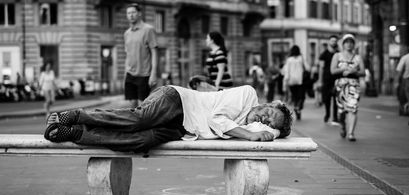Poverty is a constant issue for any nation, developed or otherwise. Its constancy does not, however, make it any less of a tragedy, especially when it's between our own borders.
In this article, we will present some poverty statistics in the UK that show how serious of an issue it is, how it developed, and what is being done to solve it.
The Top 5 Poverty Statistics in the UK for 2023
The Gini (income distribution equality) index is at 0.34.
Almost 15% of pensioners live in poverty.
Absolute poverty rates are almost twice as high for black and Asian children, when compared to white children.
3.9 million children live in poverty in the United Kingdom.
Current inflation rates are as high as they were in the 1980s.
General UK Poverty Stats and Facts
One definition of poverty, provided by the Joseph Rowntree Foundation, is simply “poverty is when a person’s resources are well below their minimum needs, including the need to take part in society”. Let's see what poverty looks like in the United Kingdom
13.4 million people were living in poverty in the UK, in 2020/2021
In other words, 20% of the population. Poverty statistics show that of this number, 1.7 million were pensioners, and 3.9 million were children.
It also needs to be noted that poverty rates have dropped since the 1990s for working-age parents, pensioners, and children. For working-age adults without children, however, poverty rates have increased.
(Joseph Rowntree Foundation, House of Commons Library)
Data showing a drop in poverty during the Pandemic does not give a complete picture.
While there was a drop in both relative and absolute poverty between 2019/2020 and 2020/2021,the data is imprecise because of two possible reasons:
There was an increase in benefits through special programs (like the Universal Credit uplift) for benefit recipients during the Pandemic.
The relative poverty line was pushed down due to job loss among low paid workers and the income reduction for furloughed workers.
(House of Commons Library)
Absolute child poverty numbers decreased while relative child poverty numbers increased in the years leading up to the pandemic.
In 2019/2020, the last year before the Pandemic, 25% of children were in absolute poverty, lowered from 28% in 2013/2014. Relative child poverty increased from 27% in 2013/2014 to 31% in 2019/2020.
Note that in the UK relative poverty is defined as living in a household whose income is 60% of the average income in the country, and is able to meet their basic needs and little else above , while absolute poverty refers to households that do not have the minimum amount of income to meet minimum living requirements.
(Institute for Fiscal studies)
Poverty causes a host of societal, health, and mental problems.
29% of UK workers claim financial worries had a negative effect on their productivity. The greater the level of poverty, the worse its consequent problems are.
Some of the consequences of poverty are:
Housing problems
Being a victim of a crime
Early childhood poverty harms brain development
Drug or alcohol issues
Lower educational achievement
(Joseph Rowntree Foundation)
The highest inflation rates in almost forty years are eroding household income.
In 2022/2023 we are seeing inflation rates as high as they were in the 1980s lowering the real value of a person's income, making it essentially worthless.
Some other major causes of poverty in the UK are:
Unemployment and low-paying jobs with poor prospects and security
An ineffective benefits system
An increasing cost of living
Discrimination
Abuse and trauma
Low education and skill levels
(Institute for Fiscal Studies, Joseph Rowntree Foundation)
The Gini index dropped slightly, from 0.35 in 2019/2020 to 0.34 in 2020/2021.
The Gini index represents the level of income distribution among a country’s population. A high Gini index represents high inequality, where more money is distributed among fewer individuals.
It's now at the same level it was in the 1990s, but still much higher than where it was in the 1970s, which was at 0.24
(Institute for Fiscal Studies)
The Joseph Rowntree Foundation has a five-point plan to solve poverty in the UK.
Their goal is that by 2030 no one will be in poverty for more than two years, that less than 10% of the population is in poverty, and that no one is ever, at any point in time, destitute.
The five points through which they want to achieve this are:
Increase citizen incomes, reduce costs
Develop an effective benefit system
Improve education and increase worker skills
Strengthen families and communities
Promote long-term economic growth.
(Joseph Rowntree Foundation)
20% of poor households experienced food insecurity in 2020/2021.
Furthermore, 25% of households that received Universal Credit also experienced food insecurity during that period.
(Joseph Rowntree Foundation)
Four in ten of the poorest families with children are spending less on food for their children in 2022.
Data on poverty in the uk also shows the poorest 20% of households, half of them have reduced spending on food for adults, 50% are reducing the number of showers they are taking, and 60% are heating their homes less.
(Joseph Rowntree Foundation)
According to the JRF, there are five elements within the benefits system that increase poverty.
According to scientific data and facts about poverty gathered by the JRF, these elements are:
The benefit cap
The two-child limit for benefits
Local Housing Allowance rates not taking into account the link between housing costs and benefits
The five-week wait for Universal Credit payments
Unaffordable debt deductions from benefits
(Joseph Rowntree Foundation)
Poverty in the UK: A Demographic Overview
Since the 1965 International Convention on the Elimination of All Forms of Racial Discrimination (or CERD), any and all forms of discrimination have been made illegal in the UK. Inequality still exists, however, and in this section we will explore how much.
Northern Ireland and Scotland have lower poverty rates than the rest of the UK.
Poverty statistics in the UK show that, at least for Ireland, one of the core reasons its rates are lower is due to the (relatively) affordable housing costs when compared to the rest of the United Kingdom.
However, it also needs to be mentioned that wages are lower in NE, when compared to the rest of the UK.
(Joseph Rowntree Foundation)
In Britain 46% of ethnic minority children are living in poverty.
As for the UK, there is a strong disparity in employment among different ethnicities. For working age people (16 to 64 years old), 76% of whites are employed, compared to 67% of other ethnic groups. However, this underemployment level has gone down between 2004 and 2021 by 7 points.
Pakistani and Bangladeshi ethnic groups have the lowest employment levels, at 58%.
(Runnymede Trust, Gov UK)
15% of pensioners live in poverty.
However, poverty statistics show that these numbers have dropped by 3 percentage points between 2019/2020 and 2021/2022.
Furthermore, pensioner poverty rates have seen a significant drop when compared to the 1990s, where they were at 29%. They dropped to 13% in 2012/2013, and rose to 18% in 2019.
(Joseph Rowntree Foundation)
Absolute poverty rates were much higher for black (43%) and Asian (41%) children when compared to white children (22%).
For children of mixed ethnicities, 38% of them live at the absolute poverty level.
These numbers are lower when compared to 2013/2014, when 50% of black children were at the absolute poverty level.
(Institute for Fiscal Studies)
There is great racial disparity in wealth on the Island.
For every £1 within a White household, statistics on poverty show that Bangladeshi and Black African households get 10 pence, Black Caribbean households have 20 pence, Pakistani have 50 pence, while Indian households are the closest, at 90 to 95 pence.
(Runnymede Trust)
Conclusion
Poverty still remains a persistent issue in the UK, affecting a significant portion of the population. Despite efforts to address the root causes of poverty and implement policies to reduce its impact, rising inflation levels will only exacerbate the issue. It is crucial for the government and society as a whole to prioritize dealing with poverty, and to ensure that its citizens have the opportunity to build a brighter future.

.jpg)
.jpg)

.jpg)
.jpg)

